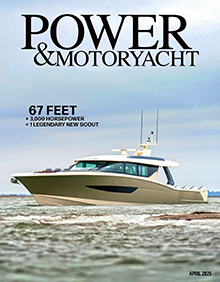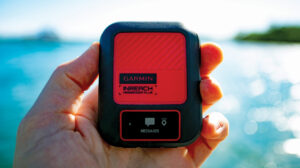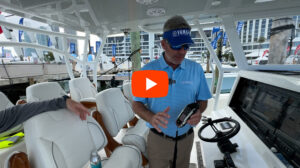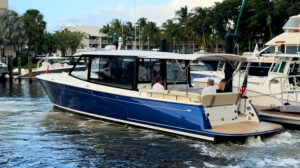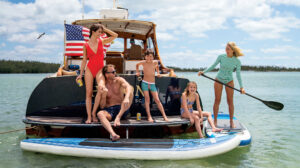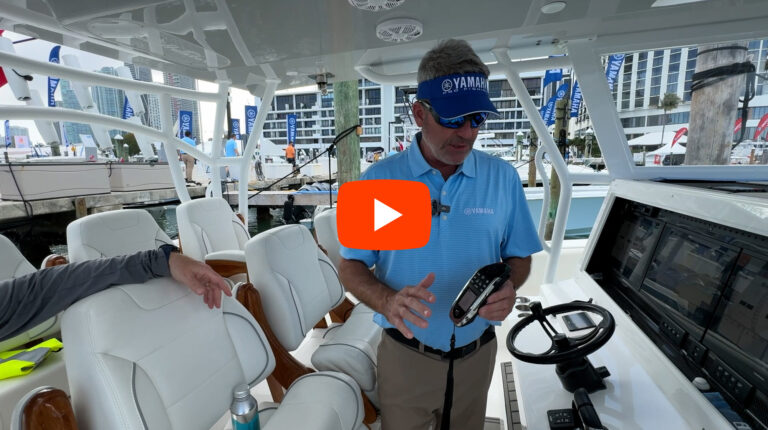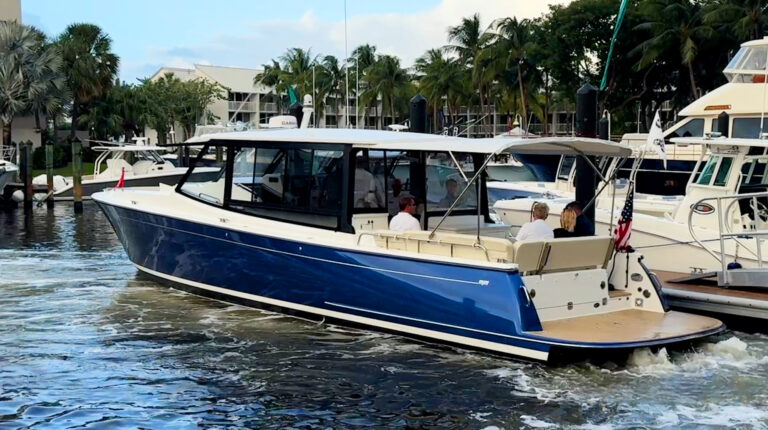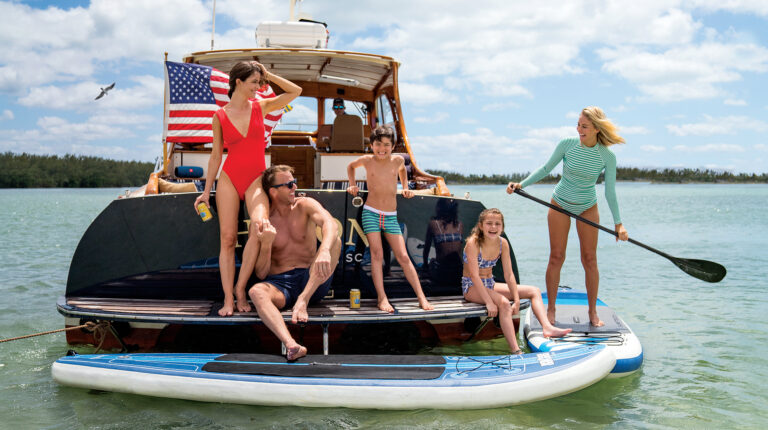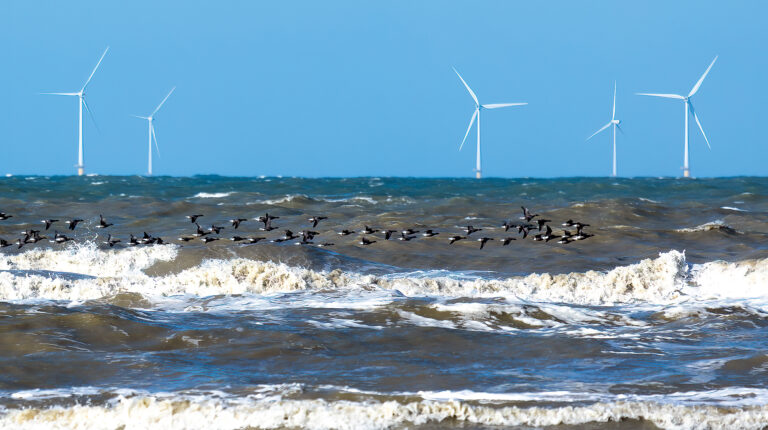
The seven-inch Alden AE-3300 alongside the Icom R2500 with its second, non-PC control head.
Wideband is not broadband. If you boat far from civilization, you’ll still find even a moderately fast Internet connection elusive (see KVH FleetBroadband for the costly details), but bluewater boaters have been using wide swaths of radio spectrum since before communications satellites were even a dream. Short wave (also known as HF and AM), amateur radio (HAM), marine single sideband (SSB), Weatherfax, Navtex, and Telex are only the more familiar broadcast types you can tune in with a receiver that can handle a wide variety of frequencies and modulations.
But getting some of those modes out of a normal stand-alone receiver or transceiver involves a lot of moving electrons. For instance, you can use specialized software to decipher Weatherfax and Navtex broadcasts on a boat’s computer if it is wired to an SSB radio via either the PC’s audio-in port or via a special modem. So I was keen to test the Alden AE-3300 wideband receiver because it’s completely controlled by built-in software that would supposedly let me not only grab NOAA weather graphics and text, but also listen in on any frequency from 9 KHz to 30 MHz.
I was not disappointed. At night if I left the AE-3300 on one of the Coast Guard’s Boston Weatherfax frequencies (already on the unit’s memory list), the next morning I’d usually have a set of faxes saved as jpg files that I could review in the Alden software or elsewhere. Tuning in at the right time usually got me a neatly organized set of Navtex messages, which include useful navigation warnings as well as weather information.
Now I say “usually” because success was dependent on “propagation” between Boston and my midcoast Maine test setup (which includes a good antenna but also the hills and trees around the lab). Propagation is a term for the many factors that affect far-traveling radio waves, including whims of the ionosphere and even solar flares. Propagation issues like the need to use different frequencies at different times of day and season, plus just the static common to long-range radio, are why some boaters have stopped using SSB, usually in favor of a satphone also set up for weather data downloading. After all, the same Weatherfaxes and Navtex are available that way, plus much more.

Alden’s receiver software, showing how it automatically demodulated a Weatherfax.
But there’s a sweet side to radio- wave propagation: When the solar flares or other propagation variables are right, you can pick up signals at great distances. On several mornings I was able to listen as the HAMs of the Waterway Net shared info and comraderie from boats and shore stations all along the Intracoastal and beyond, including the familiar voice of Capt. Marti Brown all the way from her mooring off Marathon, Florida. I know Brown from boat shows and her useful book Marine SSB Radio for “Idiyachts”. In fact, I am an “idiyacht” when it comes to wideband radio, a feeling that was especially reinforced when testing the Icom R2500.
Like the $780 Alden, the Icom is a black-box, PC-controlled wideband radio, but even wider (10 kHz to 3,300 MHz) and with a lot more controls and options designed to surmount propagation vagaries. The R2500 is actually one of four models that range from $500 to $900, this being the top-of-the-line unit with an alternate control head so you don’t always have to use the PC and also a second receiver so that a (smart) user might, say, listen to the BBC while a Weatherfax slowly and quietly demodulates in the background.
However, the standard Icom PC radio software—designed for general, not marine, use—does not do faxes, Navtex, etc. The Alden, by contrast, even has tools for cleaning up faxes that come in askew and can be scheduled to change channels so that the box/PC can collect fax, Navtex, Telex, and even MF and HF DSC messages 24/7 without intervention. Now there is third-party decoding software for the Icom wideband series that will do much of what the Alden includes, and Icom is including one version as a promotion these days, but I haven’t tried it yet.
As for reception performance, the two radios were pretty similar in my testing—that is until I installed a $140 Icom accessory card designed to filter out noise, which it did quite well. Frankly, I’m still learning how to use all the tweaks already built into the R2500, and it also has a ton of scanning modes that the Alden lacks altogether. Both radios, by the way, can record on-air audio, which is quite useful when listening to offshore weather forecasts.

Icon’s receiver software has extensive abilities to save and scan frequencies.
The obvious conclusion is that the Alden is right for a boater who mainly wants the utility of a marine-oriented wideband receiver, while the Icom series is more appropriate for those willing to suffer more complexity in search of better value and especially in search of all the interesting, but largely nonmarine, content that’s crackling around the ionosphere. I heard all sorts of intriguing foreign shortwave stations and HAM conversations using both radios—and I’m a newbie. But the Icom was particularly adept at exploration, plus there is an online world of enthusiasts using these particular radios and even a free service for downloading frequency lists, like all the marine SSB coast stations in Maine.
I’ve never really cruised with wideband radio, but I surely remember the magic of tuning in local AM and TV stations in foreign ports, a magic easily lost to the convenience of packaged satellite entertainment. Hence my dream offshore cruiser might at least have a wideband receiver. But it’s not absolutely necessary. Last summer I passaged from Bermuda to Maine on a boat equipped with both Globalstar and Iridium phone/data setups and an SSB transceiver. You can read all about it at my blog, but the salient facts are that both phones worked OK for voice and e-mail/weather downloads. And we hardly used the SSB, though had it been my boat, I might have been spinning the dials a bit, looking for cruising nets or just a little…ssttssttsstttsss…radio magic.
For more, visit Ellison’s blog at Panbo.
This article originally appeared in the January 2008 issue of Power & Motoryacht magazine.

